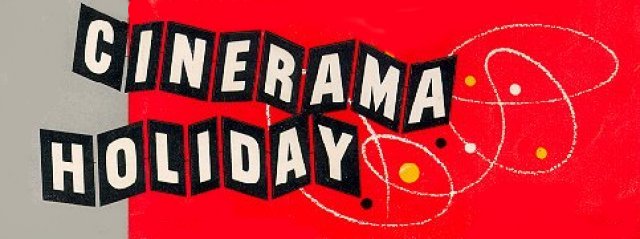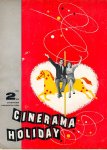
The California Zephyr as Movie Star in...

Following the technical, if not popular success of the break-through film This is Cinerama in 1952, producer Louis de Rochemont decided to make a film that was about people, rather than just places. The result was Cinerama Holiday, the story of two young couples, one American and one Swiss, who visit each others' countries. As Fred and Beatrice Troller of Zurich toured America, it was natural that the producers would pick the California Zephyr as the means of transcontinental travel. Cinerama Holiday met with the success its predecessor didn't, and became the highest grossing film of 1955.

 Filming aboard the CZ was a challenge, as is described in
the Cinerama Holiday program: "Three months of
preparation were required for the California Zephyr
sequence. A Vista-Dome railroad car was removed from
service and modified to accomodate the Cinerama camera.
The tinted plexiglass used in the dome was replaced with
clear glass to allow color photography. Special platforms
were added to enable the camera to work inside and outside of the train. A
special train schedule was fixed six weeks prior to the start of production; the
entire system of three railroads was coordinated with that of the scheduled trains. The Cinerama
trucks were routed separately to meet the train each evening. It was, Mr. de Rochemont says, an
adventure."
Filming aboard the CZ was a challenge, as is described in
the Cinerama Holiday program: "Three months of
preparation were required for the California Zephyr
sequence. A Vista-Dome railroad car was removed from
service and modified to accomodate the Cinerama camera.
The tinted plexiglass used in the dome was replaced with
clear glass to allow color photography. Special platforms
were added to enable the camera to work inside and outside of the train. A
special train schedule was fixed six weeks prior to the start of production; the
entire system of three railroads was coordinated with that of the scheduled trains. The Cinerama
trucks were routed separately to meet the train each evening. It was, Mr. de Rochemont says, an
adventure."
 Of the scenes of the Trollers on the California Zephyr, the program says, "A
Vista-Dome tran roaring through the canyons of the Colorado gave them a
magnificent sense of the difference in size and scope between America and tiny
picture-book Switzerland."
Of the scenes of the Trollers on the California Zephyr, the program says, "A
Vista-Dome tran roaring through the canyons of the Colorado gave them a
magnificent sense of the difference in size and scope between America and tiny
picture-book Switzerland."
"The vastness of the American continent is seen from the Vista-Dome of a California Zephyr, speeding eastward over the Western Pacific Railroad, up the Glenwood Canyon of the Colorado on the Denver and Rio Grande Western, and on into Chicago on the Chicago, Burlington and Quincy."
![]() Always mindful of promoting the CZ, the Western Pacific ran an ad in the December 1955
issue of National Geographic that highlighted the train's involvement in Cinerama Holiday.
Here are close-ups of the filming scenes used in the ad.
Always mindful of promoting the CZ, the Western Pacific ran an ad in the December 1955
issue of National Geographic that highlighted the train's involvement in Cinerama Holiday.
Here are close-ups of the filming scenes used in the ad.
The Cinerama process simulated 3-D by projecting the picture on an extra-wide, curved screen where the eye's periphial vision would give the viewer a semi-3-D image without the traditional 3-D glasses. To do this, the image was actually three: the camera shot three strips of film through three lense and through a single shutter. In the theater, three projectors were used, and the screen was so deeply curved, that to prevent reflections from one side to another, it was actually made up of 1100 "venetian-blind" type louvers. The sound was cutting edge, too, with six microphones being used during filming, and seven speakers surrounding the audience in the theater. The program demonstrates this with a schematic drawing produced by Stanley Warner Cinerama Corp and the editors of Popular Mechanics Magazine
There is still one print of Cinerama Holiday still in existence, and it is currently playing at The New Neon Movies in Dayton, Ohio thanks to the efforts of Cinerama expert John Harvey (click here to get to their web site). CyberTheater, the Bradford Museum in England and Wide Gauge Film and Video Monthly all have good background information on the Cinerama process.
(Thanks to Bob at ANTQNUT@aol.com for the WP 804A scan and some of the program text!)